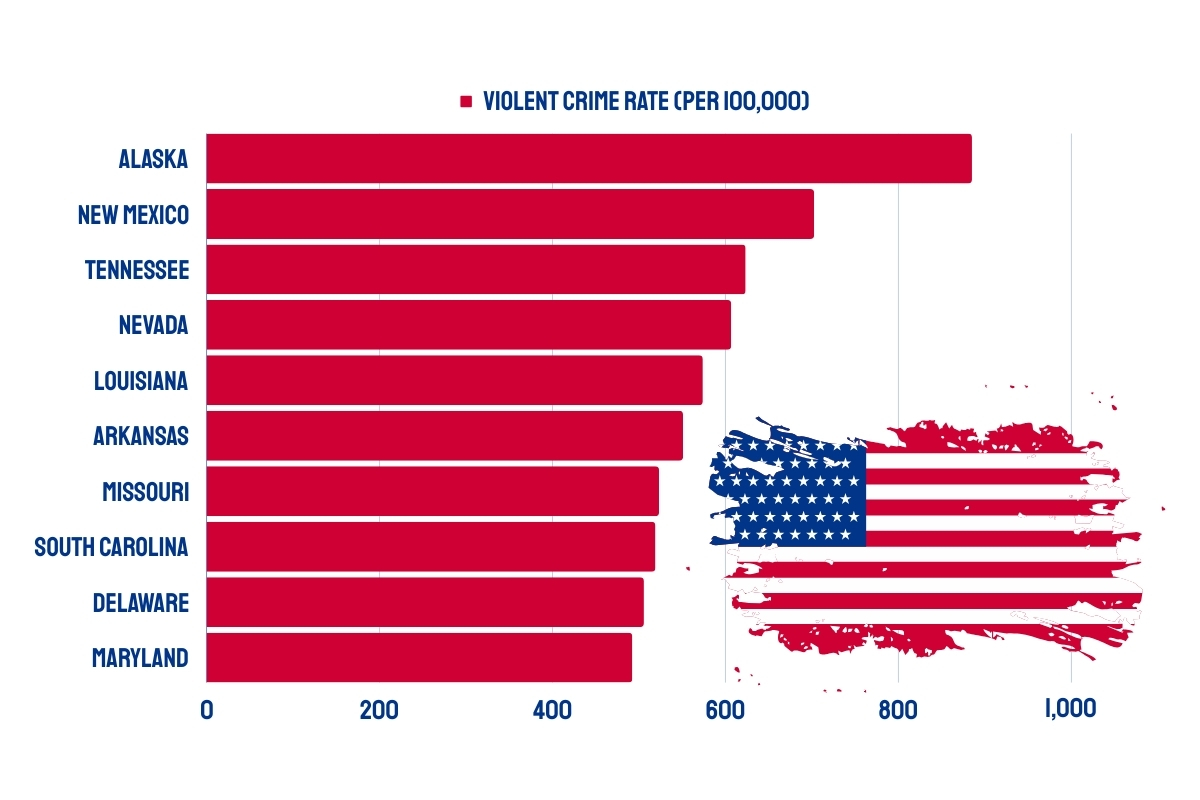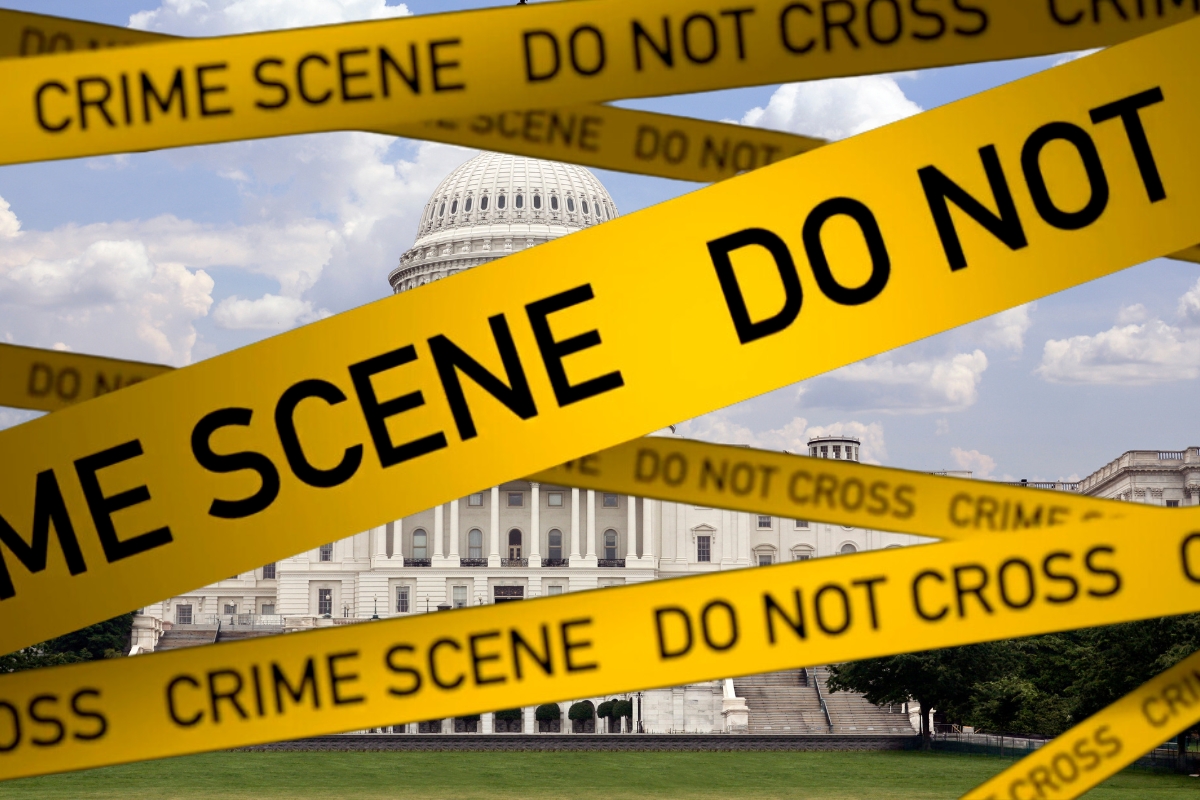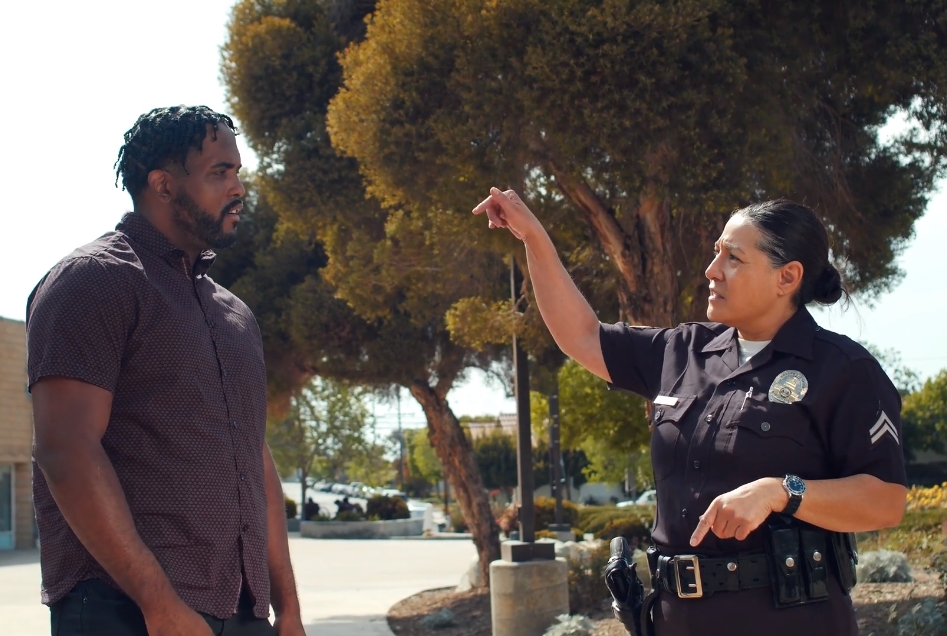| State | Total Score | Financial Safety | Personal and Residential Safety | Road Safety | Workplace Safety | Emergency Preparedness |
|---|---|---|---|---|---|---|
| Alabama | 3768 | 41 | 36 | 42 | 37 | 46 |
| Alaska | 5452 | 16 | 37 | 27 | 21 | 2 |
| Arizona | 5295 | 20 | 33 | 49 | 9 | 8 |
| Arkansas | 3372 | 43 | 47 | 47 | 47 | 33 |
| California | 4894 | 22 | 42 | 40 | 18 | 19 |
| Colorado | 4384 | 8 | 44 | 31 | 43 | 28 |
| Connecticut | 5988 | 23 | 1 | 17 | 27 | 17 |
| Delaware | 5136 | 29 | 23 | 25 | 33 | 13 |
| Florida | 3952 | 25 | 32 | 46 | 44 | 42 |
| Georgia | 4527 | 44 | 22 | 39 | 25 | 34 |
| Hawaii | 6036 | 14 | 14 | 20 | 13 | 4 |
| Idaho | 5467 | 18 | 16 | 6 | 46 | 15 |
| Illinois | 4768 | 49 | 13 | 18 | 23 | 35 |
| Indiana | 5298 | 37 | 15 | 24 | 12 | 29 |
| Iowa | 5529 | 19 | 8 | 5 | 7 | 47 |
| Kansas | 4291 | 28 | 29 | 21 | 34 | 44 |
| Kentucky | 4873 | 39 | 25 | 35 | 20 | 30 |
| Louisiana | 3164 | 48 | 46 | 34 | 40 | 49 |
| Maine | 6695 | 13 | 3 | 2 | 19 | 1 |
| Maryland | 5323 | 24 | 9 | 45 | 14 | 23 |
| Massachusetts | 6002 | 5 | 7 | 1 | 42 | 11 |
| Michigan | 4979 | 34 | 43 | 38 | 15 | 14 |
| Minnesota | 5981 | 4 | 17 | 3 | 6 | 22 |
| Mississippi | 3252 | 46 | 30 | 50 | 48 | 50 |
| Missouri | 4025 | 32 | 41 | 43 | 24 | 41 |
| Montana | 4216 | 6 | 45 | 28 | 38 | 32 |
| Nebraska | 4658 | 9 | 24 | 9 | 39 | 40 |
| Nevada | 4772 | 50 | 48 | 37 | 17 | 6 |
| New Hampshire | 6399 | 1 | 4 | 13 | 41 | 3 |
| New Jersey | 5462 | 30 | 5 | 16 | 28 | 25 |
| New Mexico | 4992 | 38 | 38 | 48 | 10 | 12 |
| New York | 5192 | 31 | 10 | 4 | 30 | 26 |
| North Carolina | 5237 | 15 | 12 | 30 | 4 | 43 |
| North Dakota | 4794 | 12 | 20 | 8 | 49 | 37 |
| Ohio | 4514 | 47 | 32 | 23 | 29 | 24 |
| Oklahoma | 3934 | 45 | 35 | 29 | 36 | 45 |
| Oregon | 5548 | 11 | 39 | 12 | 8 | 16 |
| Pennsylvania | 4851 | 35 | 18 | 33 | 26 | 27 |
| Rhode Island | 5899 | 26 | 6 | 19 | 35 | 10 |
| South Carolina | 4103 | 36 | 50 | 44 | 16 | 36 |
| South Dakota | 4338 | 3 | 28 | 32 | 50 | 39 |
| Tennessee | 4134 | 40 | 49 | 41 | 11 | 38 |
| Texas | 3677 | 42 | 40 | 36 | 31 | 48 |
| Utah | 6348 | 2 | 19 | 7 | 2 | 5 |
| Vermont | 6879 | 10 | 2 | 14 | 1 | 7 |
| Virginia | 5599 | 17 | 11 | 22 | 3 | 31 |
| Washington | 5944 | 7 | 27 | 15 | 5 | 9 |
| West Virginia | 4708 | 33 | 31 | 26 | 45 | 18 |
| Wisconsin | 5142 | 21 | 26 | 11 | 32 | 20 |
| Wyoming | 5404 | 27 | 21 | 10 | 22 | 21 |
When I think about the most dangerous states in America, I consider things like high crime rates and the types of crimes committed. For me, being informed about the crime rates in my state is crucial. I always try to be aware of different types of crime, avoid areas that might be risky, stay alert, and report anything suspicious to the authorities.
From my experience, it’s really important to know about local safety measures and take precautions, whether I’m living in a place or just visiting. In states with higher crime rates, I’ve noticed many people, including myself, consider beefing up their home security. It’s quite common to find homes with security systems, which gives a sense of safety and peace of mind.

- Stark Contrast in Crime Rates: From my research and experiences, it’s clear that states like Alaska, New Mexico, Tennessee, Nevada, and Louisiana face significant challenges with violent crime. It’s a stark reminder of the varying safety levels across the country.
- The Safe Havens: On a brighter note, states like Maine, Vermont, New Hampshire, Idaho, and Wyoming stand out for their tranquility and low crime rates. My travels there have always been marked by a sense of peace and security.
- City Safety Variations: My unsettling encounter in an unnamed city was a wake-up call to the varying degrees of safety in different urban areas. Cities like St. Louis, Detroit, Baltimore, Memphis, and Little Rock highlight the need for careful planning and awareness when traveling or relocating.
- Community’s Role in Crime Reduction: Being part of a neighborhood watch and seeing the impact of community involvement has convinced me of our collective power in combating crime. Increased police presence, better education, and accessible social services can transform high-risk areas.
- Proactive Measures Matter: Installing security systems, engaging in community safety initiatives, and staying informed are not just precautionary steps; they are essential practices in building safer environments for ourselves and those around us.
Pro Tip: Before visiting or moving to an area, research the crime rates. This will help ensure your safety and peace of mind
Table of Contents
ToggleCrime Rate Analysis: Peeling Back the Layers of US Safety Struggle
Living in such a vast and diverse country like the US, I’ve always been intrigued by how crime rates vary from state to state. So, this year, I decided to take a closer look at the crime stats, categorizing them into two main types: Violent Crimes and Property Crimes. My goal is to understand which states are the most and least dangerous.
This analysis isn’t just an academic exercise for me; it’s personal. I want to gauge the safety of living and traveling in different parts of the US.
As someone who loves exploring this great nation, having a clear picture of these crime rates is crucial for my travel plans and general awareness of the environment around me.
Factors That Contribute To This Madness
When it comes to analyzing crime rates by state, several things have a huge influence. These include:
- Poverty rates; When poverty is high, theft, burglary and violent crime increase
- Drug abuse; Where drugs are abused, robbery and assault also grow. The US opioid crisis is of particular concern, As highlighted in National Institute of Drug Abuse recent study.
- Gang activity; This brings more shootings, stabbings and aggravated assaults
- Access to guns; Easy access to guns means more gun violence and homicides
The Burden of Crime by State
According to the FBI’s Uniform Crime Reporting (UCR) program, the 5 most hazardous states in the U.S. in 2024 are:
- Louisiana: Overall Crime Rate of 537.5/100,000 people, making it the most dangerous reflecting on 24/7 Wall Street analasys.
- Mississippi: Overall Crime Rate of 413.2/100,000 people drawing insights from government statistics.
- Alaska: Despite a low population, a high Overall Crimes Rate of 386.2/100,000 people as highlighted on FBI stats.
- Kansas: Overall Crime Rate of 385.9/100,000 people.
- New Mexico: Overall Crime Rate of 369.5/100,000 people.(More info about this)
Pro Tip: Always be aware of your surroundings. Avoid risky areas and alert local authorities to anything suspicious.
Violent Crime Analysis: The Stark Reality
Below we will be exploring the Violent Crime Rates in the US for the year 2024. Moreover, we will find out which states are the most perilous to inhabit. Violent Crimes include:
- Aggravated Assault
- Robbery
- Homicide
- Rape
A recent study shows the five most dangerous states for Violent Crimes are: Alaska, New Mexico, Louisiana, Arkansas, and Tennessee.
| Rank | State | Violent Crime Rate (per 100,000) |
|---|---|---|
| 1 | Alaska | 885.0 |
| 2 | New Mexico | 702.5 |
| 3 | Tennessee | 623.3 |
| 4 | Nevada | 606.6 |
| 5 | Louisiana | 573.8 |
| 6 | Arkansas | 550.9 |
| 7 | Missouri | 523.2 |
| 8 | South Carolina | 519.0 |
| 9 | Delaware | 505.7 |
| 10 | Maryland | 492.4 |
Crime League Tables: Where Does Your State Stand?
Reflecting on the violent crime rankings across states, it’s striking how much they can differ. My awareness of this became particularly personal after a close friend had a harrowing experience in one of these high-risk states.
The most dangerous states for 2024 are:
- Alaska
- New Mexico
- Tennessee
- Nevada
- Louisiana
Just last year, a buddy of mine was vacationing in Alaska, a state known for its stunning wilderness but also, as recent data shows, for its high crime rates. He was in a seemingly safe area, but unfortunately, he found himself in the wrong place at the wrong time and was mugged.
Hearing about similar situations in other states like New Mexico, Tennessee, Nevada, and Louisiana, where the 2024 data indicates high levels of violent crime, I’m reminded of the need for vigilance. This is especially true when I travel to such places. It’s a stark reminder that safety isn’t uniform across our vast country and that being informed and cautious is crucial, no matter where you are.
Each time I plan a trip now, whether for leisure or work, I make sure to research the latest crime statistics and take necessary precautions. My friend’s experience was a wake-up call, reinforcing the importance of staying aware and being prepared, even in the most unlikely places.
1. Alaska: A Study in Contrasts
Recent studies show Alaska leads the nation in per capita violent crimes. Researchers attribute this to factors like isolation, substance abuse, and limited law enforcement resources in remote areas.”
2. New Mexico: Crime in the Land of Enchantment
New Mexico has consistently high rates of property and violent crimes. Research links this to poverty, drug trafficking routes, and systemic issues in the criminal justice system.
3. Tennessee: The Music State’s Discordant Note
Tennessee’s high crime rate, especially in urban areas like Memphis, is a focus of ongoing studies, which point to economic disparities and gang activity as key contributors.
4. Nevada: Beyond the Glitz
Nevada, particularly in Las Vegas, faces significant crime rates. Researchers point to the transient population, income inequality, and the nightlife economy as contributing factors.
5. Louisiana: Cultural Richness vs. Crime Rates
Louisiana’s crime rate, particularly in New Orleans, is often studied about its socio-economic challenges, with a focus on how cultural factors intersect with crime.
6. Arkansas: Natural Beauty and Unnatural Crime Rates
Arkansas’ crime issues, especially in Little Rock, have been linked to poverty and educational shortfalls in several studies, highlighting a need for comprehensive social strategies.
7. Missouri: Urban Crime Concerns
Missouri’s crime rates, especially in St. Louis and Kansas City, are often analyzed in the context of urban decay, racial segregation, and economic disparity.
8. South Carolina: The Palmetto State’s Struggle
Research in South Carolina shows a correlation between crime rates and factors like drug use, access to firearms, and socio-economic status, particularly in cities like Columbia.
9. Delaware: Small State, Big Issues
Delaware’s crime rate, especially in Wilmington, is the subject of studies focusing on urban poverty, drug trafficking, and the challenges of policing in densely populated areas.
10. Maryland: Complex Urban Dynamics
Maryland, particularly Baltimore, is often the focus of crime research, which examines the interplay of factors like urban blight, systemic poverty, and community-police relations.
Safe Havens: Discovering America’s Safest States
- Maine
- Vermont
- New Hampshire
- Idaho
- Wyoming
In my travels across the United States (it was in 2019.), I’ve found some states to truly stand out in terms of safety. Maine, Vermont, New Hampshire, Idaho, and Wyoming are among the safest, and my experiences there have been overwhelmingly positive.
In these states, I’ve always felt a sense of safeguard and security, largely due to their low violent crime rates in the words of U.S News. Walking through the peaceful streets of small towns in Maine or the serene landscapes of Wyoming, there’s a noticeable difference in the atmosphere – it’s calm, friendly, and welcoming.
Knowing these states have some of the lowest crime rates in the country always gives me an extra sense of ease when I visit. It’s a reminder of how understanding the safety of your surroundings can significantly impact your comfort and decisions, whether you’re traveling or considering a place to live.
Pro Tip: Stay informed and take steps to stay safe
Property Crime: The Inside Story of Break-Ins and Breakouts:
I’ve had a firsthand experience with the unsettling reality of property crime. Just last year, my girlfriend and I were victims of a break-in. It was a jarring experience that really opened our eyes to the prevalence of the same.
In 2024, my aim was to identify the most dangerous places for property crime. I pored over extensive data, seeking to inform and protect others from experiencing what my girlfriend and I went through.
It became clear that property crimes are not just statistics; they are real events that can happen to anyone, anywhere. This research was not just an academic exercise for me; it was a personal mission fueled by my own experience, driven by the hope of making our communities safer and more aware.
US Property Crime Capitals
I recently came across the FBI’s data on property crime rates in the US, which really caught my attention. It breaks down the rates of theft, burglary, and vehicle theft per 100,000 inhabitants in each state.
This data hit close to home for me, as I’ve had a personal brush with property crime. A few years ago, my car was broken into, leaving me feeling vulnerable and exposed. Seeing these statistics brought back those memories and highlighted the importance of being aware of such crimes.
According to the latest stats, it’s eye-opening to see which states have the highest rates of property crime. This information is not just numbers to me; it’s a real indicator of the safety challenges we face in different parts of the country.
- New Mexico- the highest with 3,420.2 in 2020.
- Arkansas- second highest with 3,125.2 in 2020.
- Louisiana- third highest with 2,917.4 in 2020.
- Alabama– fourth highest with 2,771.9 in 2020.
- Oklahoma– fifth highest with 2,669.5 in 2020.
Property crimes are a major issue nationwide so it’s important to take steps to protect your property. Security systems, good-quality locks, and being aware of your surroundings can help. Plus, stay vigilant and be mindful of your environment to lessen the chance of property crimes.
It’s important to stay safe. Install security systems, lock doors, and secure your belongings to avoid becoming a victim of property crime.
Fact: Property crime accounted for 71.6% of all crimes reported in the US in 2021
Infamous Metropolises: Top 10 Cities You’ll Want to Lock Your Doors In
I was visiting a city I won’t mention now, that I thought was just like any other, but one evening, I found myself in a rather unsettling situation. Walking back to my hotel, I took a shortcut through a less busy street. Suddenly, I was confronted by a group of intimidating individuals who seemed to be looking for trouble. Fortunately, nothing happened as I quickly moved away, but that experience left a lasting impression on me.
Since then, in 2024, I’ve made it my mission to research and understand which cities are the most dangerous. This isn’t just out of a personal interest; it’s become a crucial part of my planning process for travels. I believe in being fully aware of potential risks in different areas.
We already speak about that on this website!
- St. Louis, Missouri
- Detroit, Michigan
- Baltimore, Maryland
- Memphis, Tennessee
- Little Rock, Arkansas
- Milwaukee, Wisconsin
- Cleveland, Ohio
- Albuquerque, New Mexico
- Kansas City, Missouri
- Stockton, California
Crime-Fighting Playbook: Innovative Tactics to Transform Troubled Streets
High crime rates in US cities are caused by several factors. These include:
- When Pockets Are Empty: I’ve seen how poverty and joblessness can corner folks into a life of crime. It’s like watching a survival movie, but it’s real life.
- The Drug Demon: Addiction’s a beast! People will do crazy things for their next fix, whether it’s nabbing your wallet or something way scarier.
- Gangland Tales: Gangs are like the supervillains of the streets – they bring a whole lot of drama and danger to the neighborhoods they control.
- School’s Out, Trouble’s In: When education’s on the back burner, opportunity’s scarce. It’s like trying to win a race with your shoelaces tied together.
- Cops on a Budget: When law enforcement’s running on fumes, it’s like a free-for-all for the baddies. More cops and better gear could really turn the tide.
It’s important to remember that all these factors are connected. To reduce crime, it’s best to take a multifaceted approach that tackles each issue.
Initiatives to Reduce Crime Rate
In my own community, certain initiatives can really make a difference in reducing crime rates. Here’s what I’ve observed and believe in:
- Boosting Police Presence: When there are more cops on the streets, especially in those tricky high-risk areas, it feels safer. I’ve noticed a visible change in neighborhoods where police patrols have increased. It’s like having a guardian angel watching over us.
- Opening Doors to Education and Services: I’m a big advocate for education and social services. Better schools and access to social programs can change lives. I’ve volunteered in after-school programs and seen the light it brings into kids’ lives. It’s like planting seeds for a better future.
- Community Watchdogs: Neighborhood watch programs are super effective. I’m part of one, and it’s incredible how just keeping an eye out for each other strengthens the community. We’re like the local superheroes, minus the capes!
Frequently Asked Questions
1. Which is the most dangerous state in the US in 2024?
As of 2024, the state of Alaska is considered the most dangerous state in the US due to its high level of crime rates.
2. What are the main factors contributing to the dangerousness of a state?
The main factors contributing to the dangerousness of a state include crime rates, natural disasters, and other environmental hazards such as toxic waste sites.
3. How can I stay safe while living in a dangerous state?
To stay safe while living in a dangerous state, it is important to stay informed about crime rates and other hazards in your area, practice good personal safety habits, and report suspicious activity to local law enforcement.
4. What are some of the safest states in the US?
Some of the safest states in the US include Vermont, Maine, and New Hampshire, which have low crime rates and relatively low levels of natural hazards.
5. How can I find more information about the dangerousness of a particular state?
You can find more information about the dangerousness of a particular state by reviewing crime statistics, weather reports, and other relevant data sources. You can also consult with local law enforcement or community leaders for more information.
6. What steps are being taken to reduce the dangerousness of high-risk states?
Efforts to reduce the dangerousness of high-risk states include increased investment in law enforcement and emergency response services, better environmental monitoring and remediation, and the implementation of public safety programs and initiatives to train citizens to identify and respond to potential threats.
Final Thoughts
Reflecting on the journey through the landscapes of crime rates, safety measures, and personal experiences across the United States, I find myself deep in thought. It’s been a profound exploration, not just of statistics and facts, but of the real, human side of living in a country as vast and varied as the US.
I’ve been reminded, sometimes starkly, that safety is not a given – it’s something that has to be actively pursued and maintained. Each state, each city, holds its own story of struggle and resilience. From the quiet, serene streets of Maine to the bustling, edgy corners of Detroit, the diversity is astounding. It’s like a tapestry of communities, each with its unique challenges and strengths.
Through it all, what stands out to me the most is the importance of community involvement and proactive measures. Whether it’s participating in a neighborhood watch program, advocating for better social services, or simply staying informed and alert, every action counts. It’s about building a safer environment, not just for ourselves, but for our neighbors, friends, and future generations.














